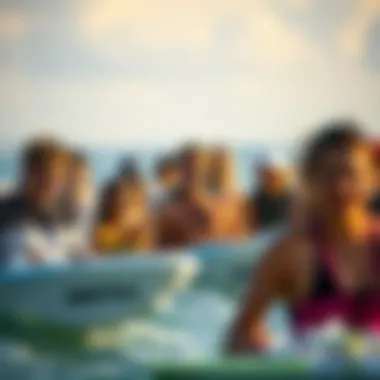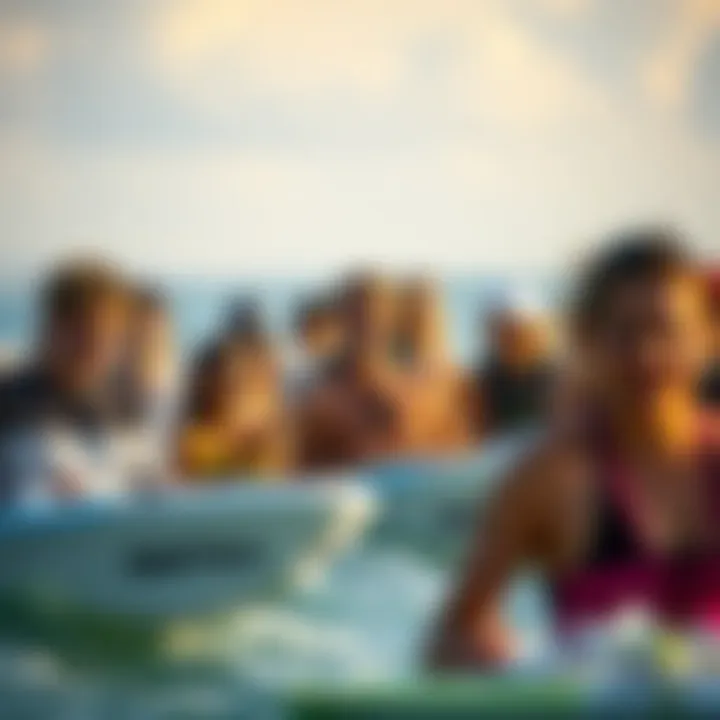Exploring Wake Foil Boards: A Comprehensive Guide


Intro
Wake foiling has become the latest sensation among water sports aficionados. Imagine gliding over the water, elevated above the surface, feeling a rush unlike any other. Whether you're a seasoned pro or dipping your toes into the foiling experience for the first time, understanding the nuances of wake foil boards is crucial.
The design and craftsmanship of these boards can make a significant difference in your overall experience. Equipped with a hydrofoil that allows you to lift off from the water, they differ fundamentally from traditional wakeboards. Moreover, the community around wake foiling is expanding rapidly, fostering innovation in gear and technique. In this guide, we'll unravel the intricacies of wake foil boards, covering everything from equipment insights to the various techniques employed by both beginners and veterans. We aim to provide you with comprehensive knowledge that not only enhances your performance but enriches your enjoyment on the water.
Equipment Insights
Latest Gear Reviews
When diving into the wake foil realm, the right equipment is paramount. Not all boards are created equal, and that’s putting it mildly. The latest wake foil boards, like the Liquid Force Kites, are designed with advanced materials that make them lighter and more responsive. They offer a flexible ride while catering to various skill levels. You also have the Slingshot Phantasm 710, which boasts rigid construction and a streamlined shape, perfect for achieving blistering speeds without compromising control.
To assist with your selection, consider the following points:
- Board Size: For beginners, a wider, longer board provides more stability. If you're more experienced, a shorter board may yield better maneuverability.
- Foil Design: Different foils will impact lift and drag. A larger wing provides more lift, while a smaller wing is ideal for speed.
- Weight Considerations: Lighter boards can lead to more agility but might require a higher skill level.
It can be beneficial to check reviews on forums like Reddit where users discuss their experiences.
Essential Gear Maintenance
Taking care of your equipment ensures longevity and optimal performance. Basic maintenance for wake foil boards includes:
- Cleaning: Rinse your board and foil with fresh water after each use to remove salt and debris. This can prevent corrosion.
- Storage: Keep your gear out of direct sunlight when not in use to reduce wear on materials. Use padded bags for added protection.
- Inspecting: Frequently check for damages, especially the foil and connections. Any cracks or bends can affect performance and safety.
Having a dedicated maintenance routine will keep your equipment in top shape, allowing you to focus on improving your skills.
Technique Exploration
Beginner Techniques
If you're new to wake foiling, start with the basics. A common entry technique is to learn the slow starts. Begin by kneeling on the board with only a slight lean forward. When you're ready, stand up gently and cease your upward pressure as you begin gliding.
Another essential technique is maintaining your balance. Keep your knees slightly bent, and distribute your weight evenly across the board to stabilize your ride. Practicing on flat, calm days is ideal until you feel secure in your control.
Advanced Maneuvers
Once you feel at home on your board, you can explore more complex tricks like 180 spins and jumps. These maneuvers require confidence and precise body control. Engaging your core can help initiate rotation while shifting your weight properly during takeoff will facilitate smoother landings.
Innovative techniques can be observed at major events or displays. Keeping an eye on trends within the community can inspire you to try new moves and challenge yourself.
Stay adaptable, as water conditions and equipment can change. The key is to refine your skills progressively while enjoying the journey of learning.
Links and Resources
For more detailed perspectives and resources, consider browsing:
- Wikipedia on Wake Foiling
- Britannica on Water Sports
- Forums and discussions at Facebook Groups and specialized sports networks.
Understanding Wake Foil Boards
Understanding wake foil boards is crucial for anyone looking to delve into this exhilarating sport. While the concept of wakeboarding is familiar to many, foiling presents a unique twist that elevates the experience on the water. Wake foil boards combine the elements of traditional wakeboards with the mechanics of hydrofoils, creating a structure that not only glides over water but also lifts above it. This transformative aspect reduces drag and allows for smoother rides, which translates to fewer bumps and more control, making it an enticing option for riders of all skill levels.
In this section, we will cover essential elements like the definition of a wake foil board, the mechanics behind foiling, and why it matters in the world of water sports. A sound understanding of these principles can enhance riders' enjoyment and effectiveness on the water.
What is a Wake Foil Board?
A wake foil board is specially designed for the act of foiling behind a boat. Unlike typical wakeboards, which rest on the water's surface, wake foil boards feature a hydrofoil that extends below the waterline. This hydrofoil consists of a wing-like structure, attached to a mast, which is connected to the board itself. The design allows the rider to be lifted above the water, significantly reducing drag and enabling higher speeds without the turbulence that traditional boards often encounter.
The materials used in building these boards typically offer a lightweight yet durable construction. Often, manufacturers opt for composites and other advanced materials that can withstand the rigors of water sports while remaining buoyant enough for optimal performance. This aspect is particularly attractive to those seeking a smoother ride.
The Mechanics of Foiling
The mechanics involved in foiling revolve around hydrodynamics—the study of how fluids interact with solid bodies. When a rider starts moving, the water flows over the hydrofoil's wings. As speed increases, the design of the foil generates lift, pulling the board (and rider) upward. The crucial factors in this dynamic are angle and speed.


- Angle of Attack: The position of the hydrofoil relative to the direction of the water flow is vital. A slight change can produce significant effects on lift and control, making precise adjustments a necessity for skilled riders.
- Speed: As with aircraft wings, the faster a rider goes, the more lift is generated. However, finding the sweet spot—where speed matches rider skills and comfort level—is essential to prevent crashes and maintain elegance on the water.
"The initial sensation of taking off is extraordinary; it feels like you’re practically flying on water."
Ultimately, the mechanics of foiling offer countless possibilities for creativity and skill development. Those who master the art of riding a wake foil board not only enjoy the thrill of gliding above the water but also unlock new techniques and tricks that elevate their wakeboarding experience.
By grasping these foundational concepts of wake foil boards and their mechanics, riders can better appreciate the sport and optimize their choice in the right equipment to suit their unique preferences and ambitions.
Components of Wake Foil Boards
When delving into wake foil boards, understanding their components is essential. Each piece of equipment serves a particular function that can affect performance, rider experience, and ultimately, the enjoyment of the sport. A deeper grasp of these components can help both novices and seasoned riders make better-informed choices regarding gear selection and usage.
Foil Design and Construction
The design and construction of a wake foil board are pivotal, dictating how the rider interacts with the water while maximizing efficiency and stability.
Materials Used
The choice of materials is vital in creating a wake foil board that is both durable and lightweight. Commonly, manufacturers utilize materials such as carbon fiber and fiberglass.
- Carbon Fiber: This material is favored for its exceptional strength-to-weight ratio. Lightweight yet sturdy, it ensures optimal performance. The rigidity enhances responsiveness during rides, but it can also come at a higher cost.
- Fiberglass: While it lacks the same level of strength as carbon fiber, fiberglass is more affordable and still provides a good level of durability. It is also versatile, allowing for varied shapes and constructions.
Each material has its pros and cons. Riders looking for top performance might lean towards carbon fiber boards, while those on a budget may find fiberglass perfectly adequate for their needs.
Hydrodynamic Shape
The hydrodynamic shape of a foil can significantly alter handling and speed on the water. A well-designed hydrofoil reduces drag, allowing the board to glide smoothly.
- Key Features: Shapes with a narrower profile typically enhance speed but require more skill to handle. Conversely, broader shapes offer stability but may sacrifice speed.
Choosing the right hydrodynamic shape aligns with a rider's skill level and riding style. Beginners should consider boards with wider profiles for easier balancing, while advanced riders might prefer more streamlined shapes to push their limits during tricks or racing.
Board Shapes and Sizes
Size and shape of the wake foil board directly impact its performance in the water. Various dimensions cater to different styles and preferences.
- Surface Area: Larger surface areas usually provide more lift at lower speeds, which can be helpful for beginners or those who want to ride at a slower pace.
- Length: Shorter boards can enhance maneuverability, making them more suitable for tricks and dynamic movements. Longer boards can offer more stability and speed for straight-line riding.
- Thickness: Thicker boards can increase buoyancy but may also add weight.
Types of Wake Foil Boards
Understanding the various types of wake foil boards is crucial for anyone looking to elevate their experience on the water. Each type possesses specific characteristics that cater to different skill levels and riding styles. Recognizing the right board for your needs can significantly enhance your performance and enjoyment, making it a key topic in this guide. To navigate through these choices, let’s break them down further:
Beginner Wake Foil Boards
For those stepping into the world of wake foiling, beginner boards are essential in helping riders build confidence and skills. These boards are typically wider and more stable, allowing users to focus on learning the fundamentals without the intimidation of harsher conditions.
Key Characteristics of Beginner Boards:
- Stability: The wider shape offers enhanced balance, making it easier to stay afloat.
- Lower Aspect Ratio: These boards typically have a lower aspect ratio which reduces the drag and helps with smoother take-offs.
- Durability: Designed to withstand the rigors of practice, beginner boards are usually constructed with robust materials.
A great option for these starters is the Liquid Force Foil Board, known for its forgiving nature and quality build.
Intermediate and Advanced Models
Once you're more comfortable and have honed your skills, you may want to consider boards designed for intermediate or advanced riders. These boards tend to be more performance-driven and cater to specific riding styles.
Key Features of Intermediate and Advanced Boards:
- Narrower and Lighter: This design helps riders achieve better maneuverability and responsiveness.
- Higher Aspect Ratio Foils: They help with speed and advanced tricks by allowing for greater lift and reduced drag.
- Construction Variations: Materials like carbon fiber can make these boards lighter and more responsive, providing an edge in competitive settings.
Brands like Slingshot are renowned for their high-performance boards suited to experienced riders.
Specialty Boards


Specialty boards are tailored for specific styles of riding, such as surfing or freestyle. These boards allow riders to engage in diverse experiences on the water beyond traditional wake riding.
Surf Foils
Surf foils are designed for wave riding, allowing for a smooth and enjoyable glide over ocean swells. They incorporate a longer, more hydrodynamic design, which makes it easier to catch waves and maintain balance.
Key Characteristics:
- Longer Wings: These provide a larger surface area for better lift in surf conditions.
- Versatility: Ideal for both paddle surfing and wake surfing scenarios, surf foils offer flexibility to riders.
- Durable Design: Built to endure the harshness of ocean waters, they often use corrosion-resistant materials.
Many riders find surf foils, like those from Naish, to be an excellent choice for both beginners and seasoned surfers, enhancing their overall performance.
Freestyle Foils
Freestyle foils are specialized for performing tricks and aerial maneuvers. Their design allows for quick pivoting and responsiveness needed to execute jumps and technical tricks.
Key Characteristics:
- Shorter Wings: Provide agility and quick response, which is essential for tricks.
- Stiffer Construction: Typically made from lightweight materials that support explosive movements and landings.
- Balanced Design: A focus on distribution allows for pop while maintaining stability during landings.
For those serious about freestyle, the Lift Foils brand has made a mark with boards that consistently deliver on performance and trick potential.
In summary, whether you're just starting out, progressing, or looking for something specifically tailored to a riding style, understanding these types of wake foil boards will help you make an informed decision. The right board can transform your experience out on the water and open doors to new adventures and challenges.
Choosing the Right Wake Foil Board
Selecting the best wake foil board can feel a bit like navigating a maze. There are multiple factors to consider and getting it right is essential for an enjoyable ride on the water. Choosing the appropriate board means understanding the interplay of your individual skill level, physical size, and preferred riding style. Let’s break down these critical elements to ensure you find a board that complements your needs and enhances your wake foiling experience.
Skill Level Considerations
Start where you stand. Your skill level plays a crucial role in determining which wake foil board is right for you. A novice may seek a stable board with a larger surface area to facilitate easier balance and control, while someone with more experience might prefer a smaller, more agile board that allows for tricks and jumps. Here’s what you should keep in mind:
- Beginner Boards: Generally, these boards have a broader base which offers stability. They help the rider become accustomed to the foiling experience without putting too much demand on their skills.
- Intermediate Boards: If you’ve got a few rides under your belt, consider boards that provide a balance of stability and responsiveness. These usually have refined shapes that enable quicker turns without forfeiting ease of use.
- Advanced Boards: For seasoned riders, the focus shifts towards performance. Look for boards that are lighter and have advanced hydrodynamics to facilitate high-speed maneuvers and tricks.
Weight and Height Factors
Your body size is another vital aspect when taking the plunge into wake foiling. The board should essentially cater to your weight and height to ensure optimal performance. A board that’s too small could lead to instability, while one that’s too large may hinder agility. Here's how to go about it:
- Weight Capacity: Each board has a recommended weight limit. Exceeding this can adversely affect your riding experience. Check the board specifications to ensure it aligns with your weight.
- Height Considerations: Taller individuals might prefer boards that accommodate a more extended stance. This aspect can dictate how you balance on the water, and finding that sweet spot can greatly improve control.
Riding Style Preferences
Everyone has their own flair when it comes to riding. Whether you’re after smooth cuts, aerial tricks, or diving below the surface, the right board can significantly affect your riding style and enjoyment. It's beneficial to reflect on what you want to accomplish:
- Freestyle Riders: If you fancy doing tricks, choose a board that is light and has flexible design elements for easier flips and spins.
- Cruisers: Boards meant for cruising should emphasize stability and comfort for long rides on calmer waters. A wider surface might serve you well here.
- Surf Style Riding: If your heart is set on mimicking the waves, look for boards that favor a surf-like feel. Those with a good rocker design can glide through water with ease.
"The right foil board can make a world of difference. It's not just another piece of equipment; it's your partner on the water!"
Choosing the right wake foil board is akin to choosing a trusted friend for adventure. By aligning your skill level, body size, and riding ambitions, you’ll find a board that isn’t just functional, but enhances every moment spent foiling. The journey requires thought and deliberation, but the resulting thrill—well, that's worth every effort.
Maintenance of Wake Foil Boards
Maintaining a wake foil board is crucial for extending its lifespan and ensuring optimal performance. Just like a car needs regular maintenance to run smoothly, your wake foil board requires attention to prevent wear and tear from the harsh water environment. Neglecting proper care can lead to severe depreciation in performance, making riding less enjoyable and possibly risking safety during use. So, let’s sail into cleaning routines and storage strategies that will keep your gear sprightly and ready to hit the waves.
Cleaning and Care
Keeping your wake foil board clean may sound straightforward, but adhering to a robust cleaning routine is vital.
- Rinse It Off: After each use, especially in saltwater, rinse your board with fresh water. This simple act helps remove salt deposits, sand, and other debris that can cause damage. Use a soft brush or cloth to scrub the surfaces and prevent any buildup.
- Check For Damage: While you’re cleaning, look for any signs of wear like scratches, dents, or fractures. Addressing small issues early can prevent them from escalating into major repairs.
- Use Appropriate Detergents: If needed, a mild soap can be used for stubborn stains. Be sure not to use abrasive materials or chemicals as they might ruin the finish of your board.
- Dry Thoroughly: After cleaning, it’s essential to let your board dry completely before storing it. This prevents mold and ensures that residual moisture doesn’t affect the board's integrity.
Remember: Regular cleaning and inspection can enhance both the longevity and the performance of your wake foil board, allowing you to enjoy smooth rides instead of worrying about equipment failure.
Storage Tips


Proper storage can make a world of difference in maintaining your wake foil board. Here are several strategies to keep in mind:
- Horizontal Storage: Whenever possible, store the board horizontally. This can help prevent warping or bending, especially if it’s in a damp environment.
- Temperature Control: Keep your board away from extreme temperatures. Storing it in a climate-controlled environment protects it from sun damage, or freezing conditions that can weaken materials.
- Use Proper Racks: Employ board racks or specific storage cases designed for wake foil boards. This not only protects the board from scratches but also helps optimize space.
- Avoid Direct Sunlight: Avoid leaving your board out in direct sunlight for prolonged periods. Ultraviolet rays can degrade materials and colors.
- Regular Checks: Even while in storage, inspect the board periodically. Look for mold, pests, or any signs of damage.
By following these cleaning practices and storage tips, you can ensure your wake foil board remains in peak condition. Preventive maintenance not only saves money in the long run but also enhances your experience on the water, allowing you to focus on the ride ahead.
Emerging Trends in Wake Foiling
As the world of wake foiling continues to evolve, staying updated with the latest trends is essential for both new and seasoned riders. The sport has recently gained traction, evolving from niche to a popular choice for water sports enthusiasts. Understanding these emerging trends ensures riders can optimize their experience on the water while also connecting with the growing community.
Innovations in Design
One significant trend shaping the landscape of wake foiling is the constant innovation in board and foil design. Manufacturers are now experimenting with various materials and shapes, leading to boards that are not only lighter but also more durable and responsive. Innovations such as carbon fiber constructions and streamlined profiles have surfaced. These materials enhance performance by increasing stiffness without adding weight, allowing riders to achieve higher speeds and smoother rides.
Another noteworthy design trend is the customization available in wake foil boards. Many brands now offer options for riders to tailor their gear, from varying widths and lengths to personalized graphic designs. This individualization helps riders find boards that resonate with their personal style and performance preferences. Riders can also adjust foil position and mast height to adapt to different water conditions.
"Finding a board that fits your style can make a world of difference in your riding experience."
Technological Advances
Technological innovation plays a pivotal role in enhancing the wake foiling experience. One of the most exciting recent developments is the incorporation of smart technology into wake foil equipment. Some boards now feature built-in sensors that track performance metrics such as speed, ride time, and even altitude, providing riders with feedback that can help refine their skills. These advancements open up opportunities for riders to analyze their performance in real-time, making the sport more engaging and data-driven.
Furthermore, advancements in hydrodynamics are resulting in foils that cut through the water with greater efficiency. New shapes and configurations, such as elevated wings or adjustable angles, are designed to minimize drag, enabling riders to feel as though they’re gliding effortlessly above the water. This change is pivotal for those looking to master their skills or simply enjoy a more exhilarating ride.
As you gear up to take on the waves, it’s wise to consider how these emerging trends can influence your wake foiling experience, making it not only more enjoyable but also pushing the boundaries of what's possible on the water.
Community and Culture of Wake Foiling
The realm of wake foiling extends beyond the boards and the water. A vital part of the experience is the community that surrounds it. Engaging with other riders not only improves skills but also creates a shared passion that can elevate the entire sport. From meeting fellow enthusiasts to participating in events, the culture of wake foiling is rich, varied, and full of opportunities.
Connecting with Other Riders
Local Meetups
Local meetups serve as a cornerstone for the wake foiling community. These gatherings allow riders to connect face-to-face, sharing tips, tricks, and stories. Such interactions can be invaluable, especially for newbies looking to learn and improve their skills. In these casual environments, everyone is welcome, whether they’re just starting or have years of experience under their belt.
A significant characteristic of local meetups is the spirit of camaraderie they foster. Riders often speak about the sense of belonging that comes from these events. This is more than just a gathering; it’s a chance to immerse oneself in an environment where everyone shares a love for foiling.
"The best part of wake foiling isn’t just the ride, it’s the friends you make along the way."
Meetup events vary greatly; some might be informal get-togethers at a local lake, while others could be organized days at popular spots like Lake Tahoe or the Colorado River. The unique feature of local meetups is their adaptability. They cater to various skill levels and interests, making them a popular choice for discovering new techniques and overcoming challenges in a supportive atmosphere.
However, it’s important to recognize that not everyone might feel comfortable jumping into a group scenario. For some, the intimidation of showcasing their skills can deter participation. Yet, most groups emphasize support and encouragement, aiming to create an inclusive environment.
Online Forums
On the flip side, online forums play a key role in connecting wake foilers from all over the world. Websites like Reddit or specialized forums are buzzing with conversations about gear, techniques, and experiences. The characteristic of online forums is their accessibility and breadth of information. Riders can post questions, share photos, and even provide tutorials, creating a rich tapestry of communal knowledge.
One of the unique features of online forums is the ability to connect with a diverse group of individuals. You might find someone from Australia discussing the best boards for local conditions alongside you. This vast network allows for varied perspectives and insights, enhancing your understanding of the sport.
While online forums provide a wealth of information, they can sometimes lack the personal touch of local meetups. It’s easy for conversations to become superficial, with some members choosing to lurk rather than engage. This can leave newcomers feeling isolated despite being part of a large online community. Yet, for many riders, the ability to explore topics at their own pace compensates for the social aspect.
Events and Competitions
Events and competitions form another pillar of the wake foiling culture, showcasing the collective passion for the sport. These gatherings not only celebrate the feats of accomplished riders but also serve as platforms to promote the growth of wake foiling as a whole. Whether informal contests or larger tournaments, events galvanize the community, offering opportunities to learn from top riders and gain exposure to new techniques.
Attending competitions can be an electrifying experience. Spectators often find themselves inspired by the skills on display and motivated to push their own boundaries. In addition, these competitive settings typically provide workshops or demonstrations, giving enthusiasts hands-on experiences that can significantly enhance their skills.
Culmination
The realm of wake foiling is expanding, and grasping the future of this engaging water sport is not just a matter of keeping up with trends; it's about setting the course for the next wave of enthusiasts. The future of wake foiling is vibrant and bursting with potential. From innovations in board and foil design to advancements in eco-friendly technology, there exists a varied array of elements worth considering.
The Future of Wake Foiling
Wake foiling has carved out a niche within the broader spectrum of water sports, offering riders exhilarating experiences coupled with the excitement of board sports. Key elements that will shape the future include:
- Sustainable Materials: As awareness of environmental impact grows, manufacturers are increasingly leaning towards the use of sustainable and recyclable materials. Boards made from bio-resins or recycled plastics are likely to become more common. This shift not only caters to eco-conscious riders but also promotes responsible recreation.
- Enhanced Safety Features: New safety innovations are on the horizon, such as advanced impact-resistant designs and integrated buoyancy aids. These features not only enhance rider safety but also encourage newcomers to join the wave.
- Smart Technology Integration: The incorporation of technology hasn't been lost on the wake foiling community. Imagine boards with sensors that provide real-time feedback on performance metrics or GPS features that track your progress on the water. Such tech could revolutionize training methods and enhance the overall experience for riders of all skill levels.
- Community Growth: The increasing popularity of wake foiling is fostering local and global communities. Riders are forming clubs, organizing meetups, and participating in competitions, enriching the culture surrounding this sport. With social media serving as a facilitator for connection, individuals can share experiences and tips, ultimately enhancing the sport's growth and popularity.
"The waters are not just for riding; they are for community, exploration, and redefining the limits of what is possible."
The takeaway from examining these trends is simple: as wake foiling continues to evolve, so too does the opportunity for innovation and community involvement. Whether you are a novice contemplating your first board or a seasoned veteran considering the latest gear, embracing the changes and advancements in wake foiling promises not only to enhance personal skill but also to deepen connections with fellow enthusiasts. Awareness of these aspects ensures that individuals are well-equipped to navigate the waves ahead.







